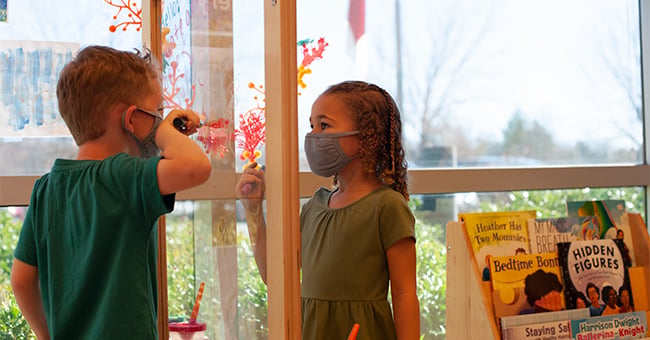
In this blog, child psychologist and early education author Dr. Ginger Welch discusses the ways children can cope with strong emotions through art, providing practical advice for parents and educators exploring the therapeutic properties of creativity.
Have you ever looked at a painting or listened to a piece of music and immediately had an emotional reaction? As much as we can benefit from an immersive stroll in a museum or a concert in which we can lose ourselves, creating art can bring us even more benefits. In fact, while there are actual fields called art and music therapy, I advocate that all artistic creation is therapeutic!
So why is art so powerful when it comes to coping with strong emotions? For one thing, it is a sensory-focused experience. The smell of the paint, the weight of a brush in our hand, the stickiness of glue as we make a collage, and the vivid colors or sharp lines that we produce fill our senses and help ground us in the moment. It becomes difficult to separate the worries that fill our minds from the artistic expressions being produced by our bodies. Many professionals call this being "fully present" as our minds and bodies come together and we are aware of every element of our experience. Children can benefit from these experiences which help them stimulate their senses, focus their attention, and release the worries of their minds.
Art is also a wonderful way to "get lost," in the best possible sense! Some people call it "getting in the flow," and if you've ever engaged so thoroughly in an artistic pursuit that you've lost all track of time, then you've been there. Much like being present, getting in the flow requires us to be intensely connected to where we are and what we are doing, but means that we are so involved in our sensory experience that we may actually tune out everything else! This is a great strategy for a child (or adult) dealing with stressors.
If I were to ask a group of adults and children, "how many of you are artists?" I feel confident that most of the children, but few of the adults would raise their hands. Children have a natural confidence in their abilities to engage with art materials without worrying about the end result; they naturally focus on the process more than the product. We need to take an important cue from children in this area: so many of the therapeutic elements of art are experiential instead of content-oriented! That is, we feel better through experience with the artistic mediums, and not just because we are thinking about our feelings. I think it surely brings us more relief to spend twenty minutes finger-painting than to complete a coloring sheet that shows different facial expressions. The latter may be produced in the name of social-emotional education, but make no mistake: it is not art!
Finally, as we welcome children back into our physical classrooms, I challenge you to increase the number and type of art experiences you have available in your classrooms. Let's break out of the "art center" and flood the classrooms, playgrounds, parent groups, and home-based activities with expressive, immersive, open-ended, and hands-on activities.
Consider some of these tips to make your art experiences more therapeutic:
Ways to Structure Therapeutic Art Experiences
- Give adequate time for the experiences and focus on self-pacing.
- Allow children to engage with art experiences more than once a day; since they aren't "making" something, don't limit participation.
- Use open-ended materials, and avoid having children reproduce things from models or examples.
Ways to Integrate Sensory Components
- Finger paint with cool paints, paint with water or ice; have warm rice bags nearby for warming hands (children may want to just play with the warmers!).
- Play with scented doughs or naturally scented petals and leaves from nature.
- Experiment with pressure by using weighted items for stamps such as a small hand weight or paperweight; hammering golf tees into paper attached to floral foam; tearing paper for collages; cutting grass with scissors; open-ended play with tape and paper; splatter painting; throwing wet sponges onto a wall on a sunny day; fabric collages; clay (takes great pressure!); playing with streamers or bubbles, especially in the wind.
- Experiment with whole body movements by making footprints in water or paint; allowing children to press their fingertips into safe ink and then jump or stretch to reach parts of a large paper attached to a wall; making a "graffiti" center out of a cardboard box that allows children to crawl inside and draw.
- Pair art with music, nature sounds, or windchimes.
Ways to Assess Therapeutic Art Experiences
- How long do children stay with open-ended, sensory focused art?
- How many times do they return?
- What do they say about their experiences?
- What sensory vocabulary do you hear?
About the Author
Dr. Ginger Welch is a former early childhood educator and current licensed psychologist and infant-mental-health mentor who has provided early intervention and early childhood mental-health services for over twenty years. As a full-time clinical associate professor at Oklahoma State University, she conducts research on early childhood trauma and child maltreatment and routinely presents at national conferences, including the National Association for the Education of Young Children and Zero to Three. Dr. Welch is the author of the resource books How Can I Help? A Teacher's Guide to Early Childhood Behavioral Health and The Neglected Child: How to Recognize, Respond, and Prevent.
